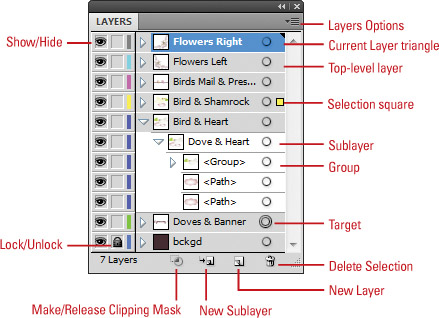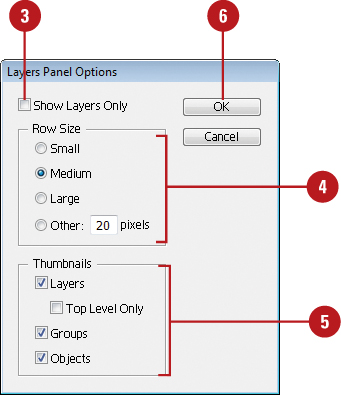Understanding the Layers Panel
With
the Layers panel, you can control elements of an Illustrator design by
assigning separate layers to each individual object. A top-level layer
appears at the top of the Layers panel, which indicates the top of the
stacking order. You can create layers and sublayers (nested layers)
within a top-level layer. The current layer in the Layers panel appears
with a black triangle in the upper right corner of the layer. The circle
icon on the right is the target, which you can use to apply and edit
appearances. A small square next to the target indicates an object
selection. The arrowhead next to a layer thumbnail allows you to
expand/collapse a layer group. To access the Layers panel, select the
Layers panel or, if the Layers panel is not visible, click the Window
menu, and then click Layers.
Show/Hide. Click this icon to show and hide the layer, sublayer, group, or object.
Lock/Unlock. Click this icon to lock or unlock the layer, sublayer, group, or object.
Target. Click this icon to apply or edit appearances for an object or group.
Make/Release Clipping Mask. Click the Lock Transparent Pixels, Lock Image Pixels, Lock Position, or Lock All button.
New Sublayer. Click this button to create a new sublayer in the active document.
New Layer. Click this button to create a new layer in the active document.
Delete Selection. Click this button to delete the active layer.
Layers Options. Click this button to access a menu of layer-specific commands.

Setting Layers Panel Options
Illustrator
doesn’t have a lot of options for controlling the Layers panel itself;
in fact, there are only a few—changing the size of the layer row and
showing or hiding layers by type. You can choose to view the layer row
size in a small (12 pixels), medium (20 pixels), or large (32 pixels)
size, or you can select a custom size. You can choose to show or hide
thumbnails based on type, including Layers, Top Level Only, Groups, and
Objects.
Set Layers Panel Options
 Select the Layers panel.
Select the Layers panel.
 Click the Options menu, and then click Panel Options.
Click the Options menu, and then click Panel Options.

 Deselect the Show Layers Only check box to show all layers. Select it to show only top-level layers and sublayers.
Deselect the Show Layers Only check box to show all layers. Select it to show only top-level layers and sublayers.
 Click an option for Row Size: Small, Medium, Large, or Other, and then enter a size (12-100 pixels).
Click an option for Row Size: Small, Medium, Large, or Other, and then enter a size (12-100 pixels).
 Select the check boxes you want for Thumbnails: Layers, Top Level Only, Groups, and Objects.
Select the check boxes you want for Thumbnails: Layers, Top Level Only, Groups, and Objects.
 Click OK.
Click OK.
